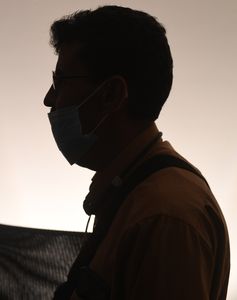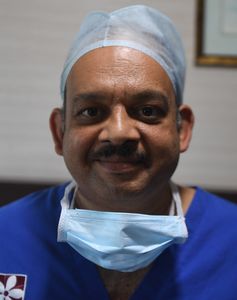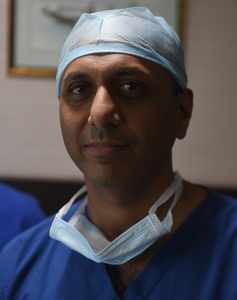On the night of March 26, 2015, Abdullah Ali, a 40-year-old farmer from the village of Al Amrah in Yemen, was fast asleep in his room. It was troubled sleep, ever since the Houthi rebels had stormed the capital city of Sanaa in late 2014 and embroiled the country in a civil war. He was concerned about the safety of his wife and 10 children. Around midnight, he was woken up when the walls of his home shuddered to the sound of an explosion. It was an airstrike. Led by Saudi Arabia, Operation Decisive Storm had officially begun, when around 100 warplanes destroyed Houthi strongholds in various parts of the country, including military hideouts, government buildings and even the Sanaa International Airport.
With the involvement of Saudi Arabia and a coalition of Sunni-majority Arab states, the war escalated. Soon, the country was in chaos, with no electricity, food or water. While the war between the Shiite Houthis, allegedly backed by Iran, and the Yemeni government backed by Saudi Arabia reached a stalemate, the civilians paid a catastrophic price. With 24.1 million people―80 per cent of the population―in need of aid and protection, the UN described the situation in Yemen as the largest humanitarian crisis in the world. Nineteen million Yemenis were likely to go hungry soon, it said.
“Before the war, life wasn’t very good, but it was bearable,” says Abdullah. “Now, it has become terrible. We have not had electricity in 10 years. Last year, hundreds of children got sick and eventually died, but they were not allowed to go out of Yemen. Most of the schools and hospitals are damaged and dysfunctional. Roads and wells here have all been destroyed. In the south of Yemen, things are a little better. But in the Houthi-controlled north, where I am from, everything is under a blockade. Fuel and food cannot be transported from the south to the north. However much I describe what is happening there, you will not be able to understand. Only if you go there can you see how dire our situation is.”
✶✶ ✶ ✶ ✶
IN MARCH 2020, the Houthis took over the strategic Al-Labnat military base in the Al-Jawf province of Yemen. Brigadier General Yahya Saree, the military spokesperson of the Houthis, stressed the importance of liberating Al-Labnat, as “it was the last stronghold of the Saudi-led coalition forces in the Jawf province, which is a key to Marib”. Marib, where the war has been raging, is one of the most strategically important cities. Former UN special envoy to Yemen, Martin Griffiths, called the Al-Jawf offensive the “most alarming military escalation” in the war. According to the UN Security Council, civilian casualties from Al-Jawf and Marib likely made up a high proportion of the 187 civilian casualties recorded in the country in February 2020.

Mohsin Muhammad, 38, was one of the men wounded by the airstrikes on Al-Jawf. It happened around 11am, when he was working on his farm. One of the wells in the farm was bombed, probably being mistaken for an ammunition depot. In the Yemen war, there are no bunkers where civilians can take refuge and no sirens announcing an offensive. You can get bombed anytime and there is no way to protect yourself. Shrapnel from the bombing struck Mohsin, and he lost consciousness. His right eyeball, and much of his orbital cavity―or the socket of the skull in which the eye is situated―was destroyed. There were three others on the farm, who took him to a nearby hospital. He was given blood transfusion and then transferred to the capital. “I didn’t feel anything when I woke up,” he says. “I was numb.”

According to the World Bank, health care in Yemen is on the brink of collapse. Only 50 per cent of the health facilities are fully functional. The rest have been damaged or destroyed, and health care workers have often been targeted throughout the conflict. “The Covid-19 outbreak, flooding, locust infestation and climate-related hazards have further compounded the impact of the conflict on people,” states a 2021 World Bank report. “In recent years, the already dire humanitarian situation in Yemen has been exacerbated by multiple and overlapping infectious disease outbreaks such as cholera and dengue.”

The Yemeni farmers say that there are only three functional hospitals in north Yemen, and all of them are overcrowded. That is why those like Mohsin had to seek treatment in India. It was not easy though. Most flights are suspended and people allowed to leave the country only according to the whim of those in power. Some Yemenis have been waiting for years to get treatment abroad.
✶✶ ✶ ✶ ✶
I FIRST MET the Yemeni farmers outside the department of maxillofacial surgery at the BMJ Hospital in Bengaluru. Some of them were dressed in traditional attire ―loose-fitting kurta-pyjamas, overcoats, and printed headscarves. But that was not the reason why they attracted attention. Rather, it was their scarred faces. Ten of them came to BMJ around three months ago. They were introduced to the maxillofacial surgeons at the hospital through Junaid, a Yemeni intermediary who first brought a wounded Yemeni to the hospital six months ago for facial reconstruction surgery. After its success, he brought the others. Two of them returned to Yemen after their surgeries, but the others are either recuperating or awaiting further surgeries.

“I felt that with my damaged face, I was not acceptable to others,” says Nasser Muhammad, 27, who did four procedures in Yemen and two in India. “I was injured in 2015, and have been suffering all these years until I came to India.” Nasser and the others say they chose BMJ because of the economical cost of treatment (around Rs3.5 lakh for each patient) and the reputation of the doctors. The money was partly paid for by the Yemeni government, and the rest collected through contributions from their villages. In Yemen, they all stand together, say the men. The war has ravaged them all, and everyone helps each other.
Nasser’s entire mid-face was injured. His eyeball and nose had collapsed with the destruction of his nasal septum. The first thing the doctors had to do was recreate the missing upper jaw. They did that with a bone from his leg. “So, what you see underneath the lip is actually bone from the leg,” says Dr Anjan Shah, one of the maxillofacial surgeons who, along with Dr Sanjiv Nair, Dr Sridhar K.R. and Dr Balasubramanya Kumar, operated on the men. They were assisted by a team of five junior doctors. The next stage was to create the partition between the nose and the mouth and put in implants. Once the foundations of the bone were fixed, the shape of the nose could be controlled. At the same time, artificial teeth were clipped on to the implants. His current teeth are temporary, so that the doctors can monitor the quality of his speech and swallowing. If required, they will make him stronger, more durable teeth before he returns. There is also a small depression under his eye. Fat from the stomach will be taken to fill it and simulate the original shape.
Many of the men came with feeding and breathing tubes, because most of their upper and lower jaws had been blown off. The doctors’ priority was to restore speech and mastication. It was more function than appearance that they were concerned with. “As long as they can walk down the street without anyone staring at them, we are satisfied,” says Shah. “Because we are never going to make them look as they did before. The scars on their face, for example, will never go. We can try to get them as near to normal as possible.”
Since the doctors did not know what the men looked like before their injuries, they simulated the surgeries on 3D-generated virtual models. There is no artificial tissue that can replace the bone of the jaw, skin of the lip or tongue, so they took bone and skin from the leg, which is a very versatile flap. Through the 3D model, a template was created to get these in the right shape. The bone was split into pieces, almost like a jigsaw puzzle. During the surgeries, they connected the bone grafts with the blood vessels in the patients’ necks, thus restoring the function of these body parts.
“There are a couple of risks involved,” says Nair. “From where we take the bone, there is a risk of the leg losing blood supply. That is a small risk, though. Normally, after physiotherapy, the patients walk within the third day. The second risk is losing the bone graft. This happens if a blood clot appears when you reconnect the blood vessels.” Normally, the surgeries take eight to 10 hours, with breaks in between to allow the blood vessels to reperfuse, or get back the blood flow.
“We do it simultaneously,” says Kumar. “So, when he is harvesting the graft, I might be preparing the head to receive the graft.”
The doctors say they were impressed with how good the surgeries done in Yemen were, even though the local flaps used had been invented during WWII, and the techniques were quite outdated. Still, the surgeries worked, mostly because the men were fit, and hence could heal easily. But they would never get in Yemen the state-of-the-art treatment they were able to get in India. “We are able to offer the same kind of treatment that is available in the first world―perfect remodelling and reconstruction of the face,” says Nair. “Even if they don’t have the money, we can raise the funds. Our goal is that nobody should go untreated.”
✶✶ ✶ ✶ ✶
IN THE EARLY 1980S, the volcanic valleys of Al-Baidha in Yemen were covered in beautiful, rain-fed terraces of wheat and other cereals, writes Helen Lackner in her book, Yemen in Crisis: Devastating Conflict, Fragile Hope. Local men were irrigating their fields through the diesel pumps they bought with their income from working in Saudi Arabia. Some of them produced qat (an Arabian shrub whose leaves are chewed as a stimulant) and other high-value crops. Within two decades, the wells had dried up. Today, many villages of Al-Baidha have been entirely abandoned, as all the ground water has gone. “Mismanagement and misuse of this basic resource has turned lovely villages into abandoned and collapsing buildings,” writes Lackner.
Abdullah Saleh Muhammad, 60, was the head of a village in Al-Baidha before he was injured. He spent his days mostly on his farm or in a village shop, where he settled disputes and acted as an intermediary between the villagers and the government.
“I was happy in Al-Baidha, with my two wives and 12 children,” he says. “I came to India for treatment because people here care for humanity. They don’t take sides. They are very kind. Indians don’t reject us just because we are from Yemen. They don’t look at religion or country. I am very satisfied with the treatment I received. I feel like India is my second home. I like it more than other Arab countries.”
For Esam, 19, what he misses most about Yemen is the delicious mandi (a traditional Yemeni dish of meat and rice) that his mother and sisters used to make. “Now, I cannot eat any solid food. I am surviving on Maggi morning, noon and night,” he says. “I am tired of it. I want to go back. I miss everything about Yemen. All those days I spent playing football and chewing qat with my friends. Most of all, I miss my fiancée, Jameela.”
But is he not afraid of going back? Of another airstrike that could take his life? “No, I love my country and am not afraid,” he says. “I keep hoping the war will end soon, and that I will be able to build a new life with Jameela.”
Yemen is the poorest country in the Middle East, and it is not easy to leave it. Travelling through Saudi Arabia is near-impossible. You would have to cross the Red or Arabian Sea and traverse many African countries to reach Europe. But even if they could, these men would not leave Yemen. The scars they bear on their face are the emblem of a country in shambles. But it is a country they are not yet ready to give up on.





